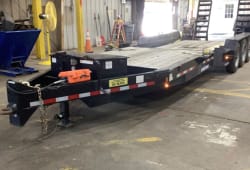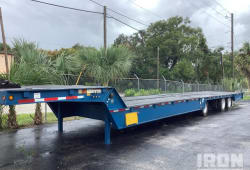All About Pipelayers: A Comprehensive Guide
5 Min read
)
October 15, 2023
Pipelayers are specialized pieces of heavy equipment designed for a specific purpose: the handling and installation of pipes in construction and infrastructure projects. These machines play a crucial role in various industries, making pipe installation more efficient and precise. In this article, we'll explore what pipelayers are, what they're used for, their various features, benefits, and downsides, and the advantages of considering used pipelayers over new ones.
What is a Pipelayer?
:format(webp))
A pipelayer is a heavy machine designed to transport, position, and lay pipes, typically used in construction and infrastructure projects. This equipment has a boom and a counterweight system that enables it to handle pipes of various sizes and weights. The operator can control the boom's movement to accurately place the pipe in the site or desired location, whether it's above ground or in trenches.
What are Pipelayers Used For?
Pipelayers have a wide range of applications across different industries and construction sites. Some common uses include:
1. Pipe Installation
:format(webp))
The primary purpose of pipelayers is to handle and lay pipes efficiently. They are instrumental in positioning pipes in precise locations, ensuring a secure and accurate fit. This is especially important in projects involving water, sewer, gas, or oil pipelines.
2. Trench Work
:format(webp))
Pipelayers excel in trenching operations, where they can lay pipes within excavated trenches. The machines can lift pipes from the ground and carefully lower them into the trench, simplifying parts of the installation process.
3. Handling Other Materials
Pipelayers are not limited to handling pipes alone. They can also manage other materials, such as culverts, concrete sections, and other heavy components.
Benefits of Using Pipelayers
:format(webp))
1. Precision
Pipelayers offer precise control, allowing the line operators to position pipes with accuracy. This is essential in ensuring that pipes are properly aligned and connected securely, reducing the risk of future leaks or damage.
2. Efficiency
The use of pipelayers can significantly speed up pipe installation projects. With their lifting and placing capabilities, pipelayers streamline the process, making completing it faster and more efficient.
3. Safety
:format(webp))
Pipelayers enhance safety by reducing the need for manual handling of heavy pipes, which can be physically demanding and risky. These machines help protect workers from potential injuries associated with lifting and moving heavy loads.
4. Versatility
Pipelayers are versatile machines that can be adapted for various applications. They can handle different pipe sizes and materials with ease, making them suitable for a wide range of projects.
Downsides of Using Pipelayers
While pipelayers offer numerous benefits, there are some downsides to consider:
1. Initial Investment
:format(webp))
Pipelayers are expensive machines, which can be a significant initial investment for construction companies and contractors. New models of pipelayers, in particular, can be quite costly.
2. Maintenance
Like any heavy equipment, pipelayers require regular maintenance to ensure they operate efficiently. Maintenance can add to the overall operating costs of running the machine.
3. Operator Training
:format(webp))
Operating a pipelayer machine requires specialized training and expertise. Finding qualified operators can be challenging, and providing the necessary training can be time-consuming and costly.
4. Limited Application
While pipelayers are invaluable for pipe installation projects, they may have limited applications beyond this specific function. This means that they may not be in use continuously, leading to idle times.
Used vs. New Pipelayers
When it comes to acquiring pipelayers, one of the important decisions to make is whether to opt for new or used equipment. Here are some factors to consider:
1. Cost
Used pipelayers are generally more affordable than new ones. This cost savings can be especially attractive for smaller businesses or projects with budget constraints.
2. Proven Performance
:format(webp))
Used pipelayers have a track record of performance. Buyers can assess the machine's history and access any maintenance records to ensure it meets their needs.
3. Availability
Used pipelayers are readily available through dealers or the second-hand dealer market. They can be acquired more quickly than new machines, which may have longer lead times.
4. Depreciation
:format(webp))
New pipelayers typically experience more significant depreciation in their early years of operation, while well-maintained used pipelayers can maintain their value over time.
5. Retrofitting
Used pipelayers can often be retrofitted with the latest technology and features, allowing them to be upgraded to meet current service industry standards and safety requirements.
6. Dealer Support
:format(webp))
Many dealers, like Boom and Bucket, offer used pipelayers with warranties and offer full after-sales service, providing peace of mind for buyers.
Conclusion
:format(webp))
In conclusion, pipelayers are essential machines for various industries and construction projects, offering precise and efficient handling and installation of pipes. While they have numerous benefits, including safety and versatility, they come with some downsides, such as the initial investment and operator training requirements. When deciding between new and used pipelayers, consider factors like cost, proven performance, availability, depreciation, retrofitting options, and dealer support to make the best choice for your specific project and budget. Used pipelayers, in particular, can offer a cost-effective and reliable solution for those looking to manage their pipe installation projects efficiently.
Visit Boom & Bucket to buy and sell your machinery.












